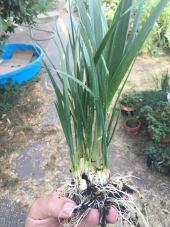





Tristan Vitali wrote:
... The big thing to watch for with them is the neck thickness - use any with thick necks as they'll be least likely to make it to spring.
Be joyful, though you have considered all the facts. ~Wendell Berry
 2
2




So Tom, do you see any storage differences among your wildcrosses?
I left them in the greenhouse with temps reaching about 110F in the day and down in the 50s at night. After about a month, I sorted them out - first removing any that rotted or softened dramatically. Then I sorted them by size. So what was left were potato onions that could really last in bad conditions.
...they never used a whole onion and so half would often go to waste. So a small onion was a plus! I would never have guessed that benefit because when I cook even for only myself, I use at LEAST one onion. Lots of onions in my diet. So the small size is a tad annoying to me, but I still like potato onions for how easily they multiply and grow, and how well they store.










 2
2




Tom Knippel wrote:
It should be noted that my crop is harvested second half of July/early August and spring planting time for me is second half of April. That is a very long time to be storing anything. (I also fall plant.)

Tom Knippel wrote:
I feel how I harvest is a major factor on keeping quality. I try to let bulbs dry down completely in the ground and then harvest cured bulbs just before the next rain. Plants finish off at a variable rate so this harvest process is repeated over a couple of weeks but always before the next rain event. POs have a short dormancy period and mature bulbs ready for harvest for storage getting wet is just not a good thing.
... I cure my crop in the ground then harvest, clean, and trim. I store my stock at a constant 50 degrees in total darkness. I inspect stored stock monthly and cull out any sprouting or rotting bulbs. Rot begets more rot, causing faster decline of remaining inventory.
 I think this counts as "infecting minds [and gardens] with permaculture".
I think this counts as "infecting minds [and gardens] with permaculture".
 1
1




Kim Goodwin wrote:
Tristan Vitali wrote:
... The big thing to watch for with them is the neck thickness - use any with thick necks as they'll be least likely to make it to spring.
That's interesting. I was wondering what other factors contribute to storage. Thanks for sharing.
I was also wondering about long day versus short day. Do you think that how far north you are is contributing to the small size? Or your shorter seasons?
I found a good writeup on potato onions on Cultivariable that I don't know if I posted above:
Cultivariable - Potato Onions
Lots of interesting info in there. Supposedly there are more long day than short day potato onions. I suspected this...it's a part of my reason for getting them going from seed in the past couple years. I'm down in the short-day latitudes.


 1
1




Cathy James wrote:"FullSkyFarm on Etsy sells bulbs and seeds from three varieties, including Green Mountain."
I have checked their offering periodically over a period of many months without ever seeing Green Mountain bulbs offered, only seeds. I would like to get some Green Mountain bulbs, which will be easy to start and breed true, rather than seeds, which are a pain to start and will be an F2 generation that doesn't breed true.
Have they stopped offering bulbs, or did they just have a year when supply didn't meet demand?
Does anyone know where I could get Green Mountain multiplier *bulbs*? Or perhaps Dakota Red, or Dakota Gold? I have been unable to find bulbs for sale for any of the varieties that Kelly Winterton created, despite a lot of looking online.














Be joyful, though you have considered all the facts. ~Wendell Berry
 1
1








Cathy James wrote:I did get some Green Mountain Multiplier potato onions, but many died the first year. I'm unsure if I will have any at the end of the second season here. They don't seem to do as well here as the common yellow-brown small potato onions.

 7
7




My Potato Onion Experiences/Pics: https://www.potatoonionguy.com

 4
4




- Tim's Homestead Journal - Purchase a copy of Building a Better World in Your Backyard - Purchase 6 Decks of Permaculture Cards -
- Purchase 12x Decks of Permaculture Cards - Purchase a copy of the SKIP Book - Purchase 12x copies of Building a Better World in your Backyard
 2
2




I'm only 65! That's not to old to learn to be a permie, right?












 8
8




- Tim's Homestead Journal - Purchase a copy of Building a Better World in Your Backyard - Purchase 6 Decks of Permaculture Cards -
- Purchase 12x Decks of Permaculture Cards - Purchase a copy of the SKIP Book - Purchase 12x copies of Building a Better World in your Backyard
 3
3




 4
4




Timothy Norton wrote:I hope you all enjoy this podcast episode as much as I did. This has Joseph Lofthouse, Holly Hansen, and Kelly Winterton discussing potato onions!
youtube vid link













 4
4




- Tim's Homestead Journal - Purchase a copy of Building a Better World in Your Backyard - Purchase 6 Decks of Permaculture Cards -
- Purchase 12x Decks of Permaculture Cards - Purchase a copy of the SKIP Book - Purchase 12x copies of Building a Better World in your Backyard

 6
6




 5
5




 3
3




Timothy Norton wrote:Great question Tristan,
My understanding (which I could be wrong, I'm new to learning about these onions as well) is that potato onions are a variation of multiplier onions. Potato onions have the ability to sometimes produce seed while also producing multiple bulbs.
Example of Multiplier Onions
1. Potato Onions (Yellow, Green Mountain)
2. Shallots
I consider Egyptian Walking Onions to be a top setting onion but I have heard arguments that they are multiplier onions in themselves. I think the term is loose enough that it catches a lot of things under it umbrella but can be used interchangeably with the official names depending on the context of the conversation.


|
Liar, liar, pants on fire! refreshing plug:
The new gardening playing cards kickstarter is now live!
https://www.kickstarter.com/projects/paulwheaton/garden-cards
|






